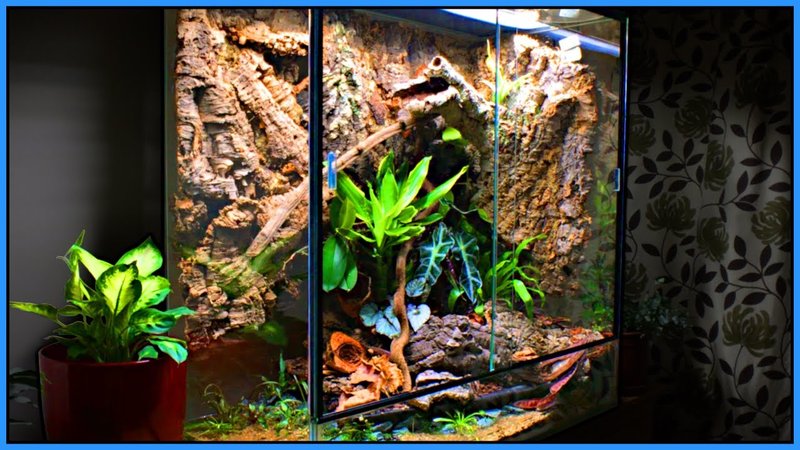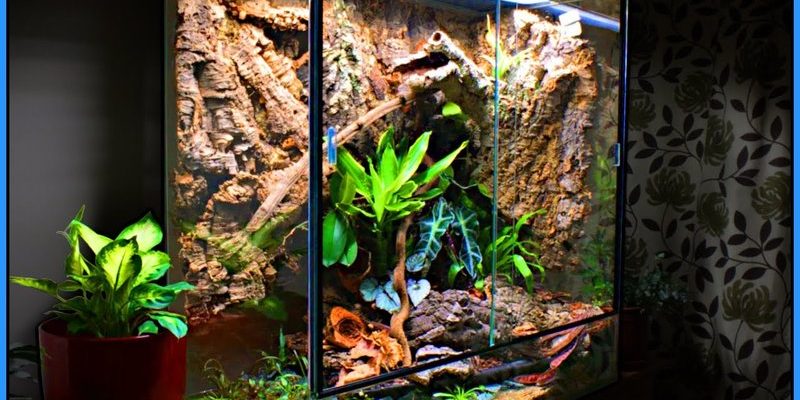
A popular choice for chameleon enthusiasts is the Exo Terra Glass Terrarium. It’s versatile, stylish, and offers plenty of options for customization. But you can certainly find other brands that suit your aesthetic and practical needs. The goal is to create a lively environment that not only looks great but also supports your chameleon’s health and happiness. Ready? Let’s get started!
Choosing the Right Terrarium Size and Type
The first step in setting up your bioactive chameleon terrarium is selecting the right size. Chameleons vary in species, and their space requirements can differ significantly. For example, a veiled chameleon thrives in a taller enclosure, ideally about 24 inches wide, 24 inches deep, and 48 inches tall. This vertical space allows them to climb and bask comfortably.
When selecting a terrarium, you’ll want to choose one with good ventilation—a must for chameleons. Look for glass or acrylic options that come with front opening doors. This makes it easier to reach in for cleaning or interacting with your pet. A well-ventilated terrarium helps maintain the right humidity levels and prevents the buildup of harmful bacteria.
Lastly, consider how you’ll maintain this habitat. A bioactive terrarium not only provides a natural look; it also helps break down waste materials through the mini ecosystem you create. So, think about how you’ll set up the drainage, substrate layers, and plants as you pick your terrarium.
Creating the Substrate Layer
Once you have your terrarium, the next step is to build a solid substrate layer. This is crucial for a bioactive setup because it fosters a habitat for beneficial organisms like springtails and isopods, which help break down waste and keep the environment clean.
You’ll want to start with a drainage layer. You can use small pebbles or Hydroton clay balls to create this base. It should be about 1-2 inches deep. This layer helps excess water drain away, protecting your plants and preventing root rot.
On top of the drainage layer, add a layer of charcoal. This acts like a filter, absorbing impurities and keeping odors at bay. A 1-inch layer should do the trick. After that, use a high-quality soil mix, free of fertilizers and pesticides. Aim for about 3-4 inches of soil to provide enough depth for your plants to root.
Finally, add a layer of leaf litter or organic matter on top. This not only helps retain moisture but also gives your chameleons a place to forage. The combination of these layers creates a thriving environment for both your plants and the creeping critters.
Choosing Live Plants for Your Chameleon Terrarium
Live plants are an essential part of a bioactive chameleon terrarium. They not only add beauty but also contribute to the ecosystem by providing oxygen, hiding places, and climbing surfaces. Some chameleons love to munch on leaves, so choose plants that are safe for them.
A few popular plant choices include Pothos, Bromeliads, and Ficus. Pothos is often favored due to its easy care and fast growth. Bromeliads offer excellent hiding spots and colorful features, while Ficus provides a sturdy climbing surface. Be sure to avoid plants that are toxic to reptiles, such as pothos or philodendrons.
When you’re arranging your plants inside the terrarium, think vertical! Place taller plants at the back and shorter ones in the front to create depth. This setup not only looks visually appealing but also gives your chameleon various places to hide and explore.
Keep in mind that chameleons adore humidity. You’ll want to mist your terrarium regularly to keep the plants hydrated and to maintain the right humidity level. A good rule of thumb is to keep the humidity between 50-70%, depending on the specific species you have.
Adding Organic Cleanup Crew: Isopods and Springtails
In a bioactive terrarium, you’ll want a “cleanup crew” to help keep things tidy. This mainly consists of isopods and springtails, small creatures that munch on waste and decaying matter. Think of them as the unsung heroes of your terrarium!
Isopods, also known as pillbugs or roly-polies, help break down organic material like leftover food and dead plants. They thrive in moist environments, making them perfect for your setup. You wouldn’t want to overload your terrarium with them—about 10-20 isopods should be enough to start.
Springtails, on the other hand, are tiny, jumping insects that feed on mold and bacteria, helping keep the soil healthy. They can reproduce quickly, so you might only need a small starter culture for the bioactive setup.
To introduce these critters, simply sprinkle them onto the substrate after you’ve added your plants. They will naturally spread out and begin their important work!
Heating and Lighting Your Terrarium
Lighting and heating are crucial when it comes to creating a healthy environment for your chameleon. Chameleons need a basking area where they can soak up UV rays and regulate their body temperature. A basking light placed at one end of the terrarium is ideal. This setup creates a temperature gradient, allowing your chameleon to choose its comfort zone.
Aim for a basking temperature between 80-90°F (27-32°C). The cooler side of the terrarium should be around 70-80°F (21-26°C). You can use a thermometer to keep tabs on the temperatures and ensure they stay within these ranges.
When it comes to lighting, a combination of a UVB bulb and a full-spectrum light can mimic natural sunlight. A 5.0 or 10.0 UVB bulb is recommended, depending on the species of your chameleon. Keep the light on for about 10-12 hours a day, which helps promote healthy growth of your plants and mimics the natural day-night cycle.
Remember to turn off the heat and lights at night to allow your chameleon to rest. They thrive on this natural rhythm.
Maintaining Your Bioactive Chameleon Terrarium
Now that your bioactive chameleon terrarium is all set up, it’s time to think about maintenance. This is where the fun really begins! Start by monitoring the humidity levels, temperature, and overall health of your plants and cleanup crew.
Misting your terrarium daily will keep humidity levels up and help your plants thrive. You might want to invest in an automatic misting system if you find yourself too busy. Just be sure to adjust it according to the specific needs of your chameleon.
Regularly check the health of your plants. Remove any dead leaves or dying plants to prevent mold and keep the environment looking fresh. If plants start to overgrow, a little pruning goes a long way in keeping things tidy.
As for the cleanup crew, they usually maintain themselves, but if you notice a decline, you can add more isopods or springtails. Just keep an eye on their population to ensure they’re doing their job.
In summary, looking after a bioactive chameleon terrarium is a rewarding experience. It allows you to connect with your pet while creating a beautiful, self-sustaining ecosystem right in your home.
Setting up a bioactive chameleon terrarium doesn’t have to be intimidating. With the right planning and materials, you can create a vibrant space that meets your chameleon’s needs. From choosing the right size and type of terrarium to adding live plants and a cleanup crew, every step contributes to a thriving environment.
Remember, patience is key. It might take some time for the ecosystem to balance itself out, but once it does, you’ll have an engaging habitat that’s not only good for your chameleon but also fascinating to observe. So brew another cup of coffee, enjoy the process, and watch your little jungle come to life!

